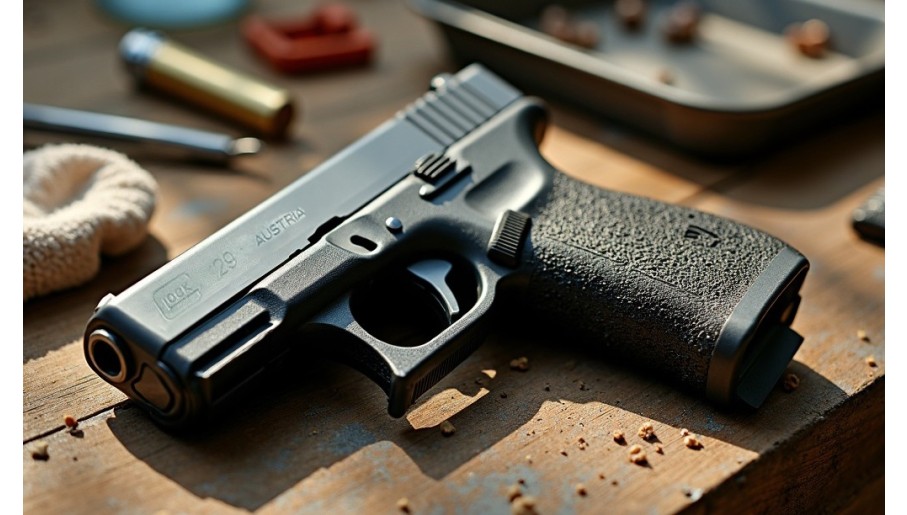You can’t judge a used gun from across the table. I picked up a Glock 29 that could be a good gun, the I racked the slide, and it was clear someone had only wiped it down. Inside: carbon, crud, hardened grease, and even sand. A full teardown, ultrasonic bath, and one channel-liner swap turned it into a dependable pistol again. Lesson: A deep clean is non-negotiable on a used gun.
The First Look: When "Fine" Isn't Fine
From the outside, the Glock looked fine. You know solid frame, fair price, no obvious abuse. But the moment I racked the slide, it told a different story: someone had only wiped it down. This wasn’t a tidy used gun; it was a project. Or in my case, the subject of my next deep-cleaning session.
The Hidden Problem with Used Guns
Backwoods hunters in Montana trust Glock 10mm pistols and .44 Magnum revolvers for one thing: backcountry protection. These aren’t safe queens; they live in rain, snow, dust, and brush. Here’s the problem: when you buy used, you’re betting your safety on someone else’s cleaning habits. From across the table, a gun can look great. Rack the slide, though, and the truth starts to leak out.
Why Deep Cleaning Comes First
Step one is always a deep clean. Not a quick field strip, a full teardown. Strip it down, clean it, inspect it, then lube only where it matters. That process turns an “unknown” into a “known.” It’s how you reclaim trust in a gun that’s lived a hard life in the mountains.
What I Found Inside This Glock 29
This Glock 29 proved the point. Inside I found:
- A striker channel packed with carbon and dried oil
- An extractor and breech face caked with crud
- Trigger components glued with hardened grease
- A barrel that looked like it hadn’t seen a brush since the Bush administration
- Grit and sand rattling around inside. Sand. In Montana. Where did he run across sand in the hills for it to infiltrate into a gun?
I’ve seen this before. Back when I had my FFL, “mystery malfunctions” showed up all the time in the form of light strikes, sluggish cycling, and failures to feed. Half the time, nothing was broken. The gun was just filthy.
So I did what I always do: a full teardown, ultrasonic bath, scrub with a nylon brush, and fresh lube on the key contact points. I swapped one hidden part (the channel liner) because on a gun with an unknown history, that’s cheap insurance. Everything else that was in the gun went back into the gun.
Back together, the Glock ran like new: no light strikes, smooth cycling, that reliable Glock thump. The sand? Gone. The grime? Gone. The worry? Gone.
The Payoff: Trust Restored
That’s the real value of a deep clean: confidence. A gun that looked like a gamble is now something you can trust. You don’t have to wonder about what the last owner did because you’ve put in the work yourself.
Your Glock Deep Clean Checklist
Don’t assume a used gun is ready just because it looks good from the outside. Rack the slide. Crack it open. Clean it properly.
Quick Glock Deep Clean Checklist:
- Field strip
- Strip the slide (striker, extractor, plunger)
- Clean striker channel bone dry
- Scrub extractor claw & breech face
- Clean frame rails, locking block, trigger group
- If you find sand/grit, check springs, pins, and recesses closely
- Lube only the key contact points
- Function check before the first range trip
Control what you can control. A deep clean is the cheapest, most effective upgrade you’ll ever give a used gun, and the one that matters most.
If you want to learn more about DIY Gunsmithing, check out my website at www.trb.fyi.
Author Bio
Jason Schaller has over 40 years of shooting experience and spent a decade as a licensed FFL gunsmith. Long before “DIY gunsmithing” was a buzzword, he was fixing and rebuilding firearms on his own bench. Today, he runs The Rogue Banshee, where he shares step-by-step guides that help everyday gun owners keep their firearms running and build confidence in their own skills. Visit him at www.trb.fyi, or on social networks like:




